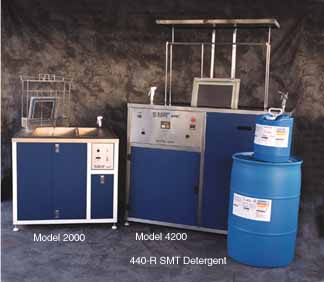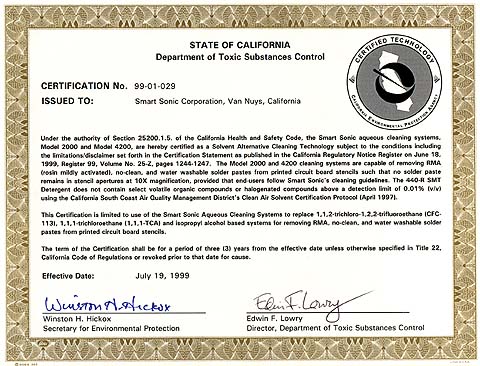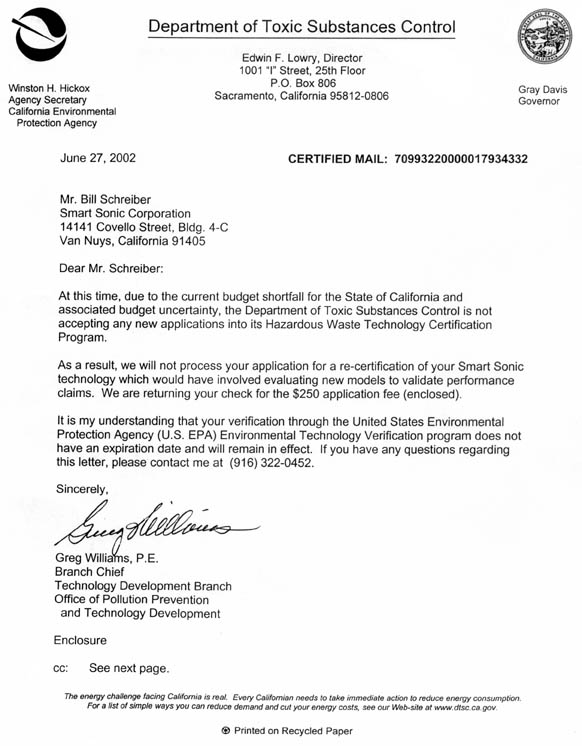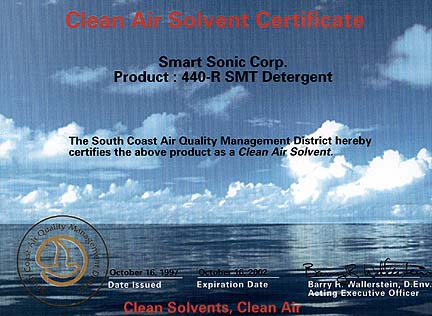从1990 年“时脉创力” 钢网清洗过程的介绍, 过程由SMT公认专家评估和测试了,及由被认可的专长领域的权威代理譬如EPA 、Cal/EPA 和AQMD的管制。其它过程在电子产业未符合这些高标准或由那么许多使有名望。顾客可以放心, 他们的决定使用 “时脉创力” 是正确的决定并且过程是被确定为安全, 有效, 快速, 经济的和环境保的。
1998 年, “时脉创力” 递交了它的钢网清洗过程给美国环境保护处和加利福尼亚环境保护处为详尽的评估。一个代表性的自动钢网清洗机(型号4200) 和一个代表性的卢自动钢网清洗机(型号2000) 被评估了使用 “时脉创力” 无危险性 440-R SMT 清洗剂。
一般加利福尼亚EPA 证明数据是有效在三年内的期间, 然而美国EPA 证明“时脉创力”数据是永久, 不到期(参见从Cal/EPA 的信件DTSC 下面) 。加利福尼亚EPA 数据的再鉴定会是重要和必要的 --- 如果整个过程改变了或使用不同化学。
从1990 年它的介绍,“时脉创力” 钢网清洗过程是唯一的钢网清洗过程满足"时间测试" 和未改变。唯一机器的外观和用户友好被改进降低化学消耗量, 引起较少污水和促进更加容易装货和卸载… 等。
今天, “时脉创力”依然是唯一的钢网清洗过程曾经通过加利福尼亚EPA 证明和完成美国EPA 的ETV 程序。其它钢网清洗机制造商或清洗过程未能达到这些严密指引。
下列是加利福尼亚EPA 证明和美国环境保护处的正式证明声明的拷贝:
华盛顿特区, 20460

环境技术证明声明
| 技术类型: | 超声波含水清洗系统 |
|---|---|
| 应用: | 清洗的印制电路板钢网 |
| 技术名字: | SMART SONIC |
| 公司: | SMART SONIC CORPORATION |
| 地址: | 2373 位出纳路, #107 NEWBURY 公园, 加利福尼亚91320 |
| 电话: | (805) 499-7440 |
| 电传: | (805) 375-5781 |
美国环境保护处创造一个程序去促进创新环境技术的部署,并通过性能检定和信息传播。环境技术证明(ETV) 程序的目标:是提高环境保护由极大地加速采纳和对创新, 被改进, 和更加有效的技术用途。ETV 程序意欲协助和通知那些个体需要可信数据为环境技术设计, 发行, 允许, 和购买。这个证明声明为 “时脉创力” 含水清洗系统提供性能表现结果总结, 注册商标SMarTSonic?。
程序操作
EPA 的ETV 程序, 在与被认可的测试组织的合作, 客观和系统的文件提供商业准备好环境技术性能。同时, 以技术开发商的充分的参与, 他们开发计划, 进行测试, 收集和分析数据, 和报告研究结果。根据一个严谨工作计划和建立的协议为质量管理去指导及证实。一旦现有的数据被使用, 数据一定由独立来源收集了使用相似的质量管理协议。EPA 的ETV 程序, 通过全国风险管理研究实验室(NRMRL), 与毒性物质控制(DTSC)的加利福尼亚部门成为伙伴,在ETV 试验计划之下核实污染预防, 回收, 和废料处理技术。
技术描述
“时脉创力” 公司开发了型号2000和4200超声波含水清洗系统去代替1, 1, 2 三氯1, 2,2-trifluoroethane (CFC-113), 1,1,1 三氯乙烷(1,1,1-TCA)和异丙醇(IPA) 基底的系统,它使用在电子产业从印制电路板和钢网去清洗各种类型的焊膏。
“时脉创力” 钢网清洗工艺包括 “时脉创力” 专利的440-R SMT 清洗剂?, 超声波发生器和40 千赫压电传感器、不锈钢清洗缸、冲洗缸(包括在半自动化的系统), 和控制装置。
半自动化的型号2000 年系统是大约以一个40 x 44 英寸基地为3 英尺高的。这个单位有一个分开的清洗缸和一个人手冲洗驻地。自动化的型号4200 系统是大约以一个36 x 62 英寸基地为50 英寸高的。使用气动升降在这个型号增高36 英寸为总系统高度86 英寸。这个系统有一个缸为清洗与自动化的冲洗在清洗缸。

The combination of Smart Sonic's 440-R SMT Detergent and ultrasonics enables the removal of solder pastes from printed circuit board stencils. Detergent surfactants act as wetting agents to saturate the solder paste layer that is left on the stencil surface (from solder paste printing operation). The ultrasonics then produce an intense scrubbing action, through cavitation and implosion of microscopic bubbles that enhances removal of the saturated solder paste layer. Ultrasonics are often more effective in cleaning hard-to-reach surfaces (i.e., small stencil apertures) than brushes and hand wipes. The cleaning bath is operated at room temperature, eliminating any potential effects to the stencil from cleaning solutions requiring higher temperatures.
EVALUATION DESCRIPTION
Between May and September 1998, an evaluation of two ultrasonic aqueous cleaning systems, developed by the Smart Sonic Corporation, was conducted using field and laboratory qualitative and quantitative data. The aqueous cleaning systems include Smart Sonic's Model 2000 and Model 4200 systems. The objectives of this evaluation were to verify, through independent sources, the following performance parameters:
The evaluation consisted of:
Details of the evaluation, including data summaries and discussion of results may be found in the report entitled 'US EPA Environmental Technology Verification Report, Smart Sonic Aqueous Cleaning Systems, SMARTSONIC® (EPA/600/R-99/004)."
VERIFICATION OF PERFORMANCE
Performance results of Smart Sonic Corporation's aqueous cleaning systems, Model 2000 and Model 4200, are as follows:
Results of the verification show that the Smart Sonic ultrasonic aqueous cleaning systems, Model 2000 and 4200, are capable of removing RMA (rosin mildly activated), no-clean, and water washable solder pastes from printed circuit board stencils such that no solder paste remains in stencil apertures at 10X magnification, provided that end-users follow Smart Sonic's cleaning guidelines. The Model 2000 and 4200 cleaning systems do not contain select volatile organic compounds and halogenated compounds above detection limit of 0.01% (v/v) using SCAQMD's CAS Certification Protocol (April 1997). End-users should follow Smart Sonic's operational and saety guidelines.
End-users should contact their stencil manufacturer prior to changing their cleaning process. Changing from solvents to aqueous cleaning systems may require stencil modifications to make the cleaning system and stencil compatible. In addition, the end-user should contact his/her local, state, or federal regulatory authority regarding management of spend hazardous wastes generated from use of the Smart Sonic aqueous cleaning systems (i.e., spent cleaning baths, rinse baths, and solids containing lead).
| E. Timothy Oppelt | James T. Allen, Ph.D., Chief | ||
| Director | Office of Pollution Prevention | ||
| National Risk Management Laboratory | and Technology Development | ||
| Office of Research and Development | Department of Toxic Substances Control | ||
| United States Environmental Protection Agency | California Environmental Protection Agency | ||
| NOTICE: Verifications are based on an evaluation of technology performance under specific, predetermined criteria and the appropriate quality assurance procedures. EPA and Cal/EPA make no expressed or implied warranties as to the performance of the technology. The end-user is solely responsible for complying with any and all applicable federal, state, and local requirements. |
Availability of Verification Statement and Report
Copies of the Public Verification Statement (EPA/600/R-99/004VS)
and Verification Report (EPA/600/R-99/004) are available from the following:
(Note: Appendices are not included in the Verification Report.
Appendices are available from DTSC upon request.)



The Smart Sonic Stencil Cleaning Process is listed by the Oregon Department of Environmental Quality (DEQ) as an Alternative Cleaning Process. Please visit the Oregon DEQ website for details: http://www.deq.state.or.us/programs/p2/p2.htm

Smart Sonic's 440-R SMT Detergent is certified as a "Clean Air Solvent" by the South Coast Air Quality Management District CAS Program.
CAUTION: The Clean Air Solvent (CAS) Program only certifies the chemistry. If a CAS chemistry is used in a hazardous stencil cleaning application (lead) the resulting waste stream is not CAS certified. Only the Environmental Technology Verification (ETV) Program of the EPA tests and verifies complete processes.

| TO: Anupom Ganguli, Sr. Manager VOC Rules and NSR Stationary Source Compliance SAMPLE DESCRIBED AS:
SOURCE: 2373 Teller Road, #107 Newbury Park, CA 91320 |
LABORATORY NO. 92597-02-001 REFERENCE NO. SK-15-122 DATE RECEIVED: 9-16-97 SOURCE I.D.# None SUBMITTED BY: Lou Yuhas |
| Date Approved: 10/14/97 | Approved by: Rudy Eden, Sr. Manager Laboratory Services |
The Smart Sonic SMT Screen/Stencil Cleaning Process is the only truly environmentally safe cleaning process. California's Air Quality Management District has certified Smart Sonics's 440-R SMT Detergent as a "Clean Air Solvent" (1997).
Most people will agree that California is the most environmentally regulated area in the world. The regulating agency in Northern California (Silicon Valley) is the Bay Area Air Quality Management District (BAAQMD). The BAAQMD has exempted the Smart Sonic Cleaning Process from all permit requirements because of it's environmental compatibility!
The following is a letter from the BAAQMD to a Smart Sonic customer in the Silicon Valley area:
| Parameter | Results | Method |
|---|---|---|
| Waste Water Effluent | 19 mg/L | EPA 239.2 |
| Distillate | < 0.2 mg/L | EPA 239.2 |

The Smart Sonic SMT Screen/Stencil Cleaning Process is not only environmentally safe, it is the safest way for personnel to clean solder paste. There is no hot water to scald personnel, the are no hazardous vapors to breathe and the are no concerns about combustibility and/or explosion as there are with systems using alcohol and terpenes.